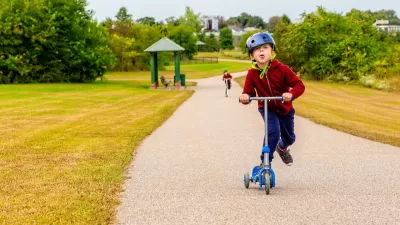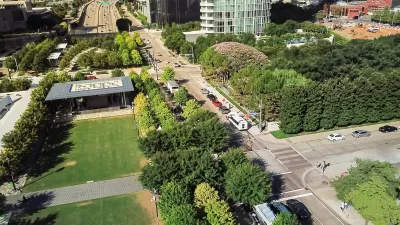Opening schoolyards to the public could be 'game-changing' for communities lacking in green space.

The Trust for Public Land's Community Schoolyards report highlights the potential for the country's public schoolyards to serve as public parks. The Trust "believes that transforming America’s schoolyards into shared public parks by 2030 is a common-sense, cost-effective solution to America’s park equity problem. Opening all public schoolyards during non-school hours would put a park within a 10-minute walk of nearly 20 million people—solving the problem of outdoor access for one-fifth of the nation’s 100 million people who don’t currently have a park close to home."
The report also outlines steps schools can take to make their schoolyards more inviting, healthy, and safe. These suggestions include "[s]wapping out blacktop for trees, gardens, and up-to-date play equipment," which "would deliver a raft of benefits to students, from emotional to academic."
According to analysis conducted by the Trust, "[i]n the 100 largest U.S. cities, neighborhoods where residents predominantly identify as people of color have access to an average of 44 percent less park acreage than predominantly white neighborhoods." Community Schoolyards seeks to reimagine the drab asphalt schoolyard as an inspiring, healthful environment for both students and the community at large. "Renovated schoolyards can also serve as vital green space for the entire community. Growing numbers of districts are allowing local residents to use their school grounds after school and on weekends, giving not only students but people of all ages new access to parkland."
FULL STORY: A game-changing solution to America’s park equity problem

Study: Maui’s Plan to Convert Vacation Rentals to Long-Term Housing Could Cause Nearly $1 Billion Economic Loss
The plan would reduce visitor accommodation by 25,% resulting in 1,900 jobs lost.

North Texas Transit Leaders Tout Benefits of TOD for Growing Region
At a summit focused on transit-oriented development, policymakers discussed how North Texas’ expanded light rail system can serve as a tool for economic growth.

Why Should We Subsidize Public Transportation?
Many public transit agencies face financial stress due to rising costs, declining fare revenue, and declining subsidies. Transit advocates must provide a strong business case for increasing public transit funding.

How to Make US Trains Faster
Changes to boarding platforms and a switch to electric trains could improve U.S. passenger rail service without the added cost of high-speed rail.

Columbia’s Revitalized ‘Loop’ Is a Hub for Local Entrepreneurs
A focus on small businesses is helping a commercial corridor in Columbia, Missouri thrive.

Invasive Insect Threatens Minnesota’s Ash Forests
The Emerald Ash Borer is a rapidly spreading invasive pest threatening Minnesota’s ash trees, and homeowners are encouraged to plant diverse replacement species, avoid moving ash firewood, and monitor for signs of infestation.
Urban Design for Planners 1: Software Tools
This six-course series explores essential urban design concepts using open source software and equips planners with the tools they need to participate fully in the urban design process.
Planning for Universal Design
Learn the tools for implementing Universal Design in planning regulations.
City of Santa Clarita
Ascent Environmental
Institute for Housing and Urban Development Studies (IHS)
City of Grandview
Harvard GSD Executive Education
Toledo-Lucas County Plan Commissions
Salt Lake City
NYU Wagner Graduate School of Public Service





























